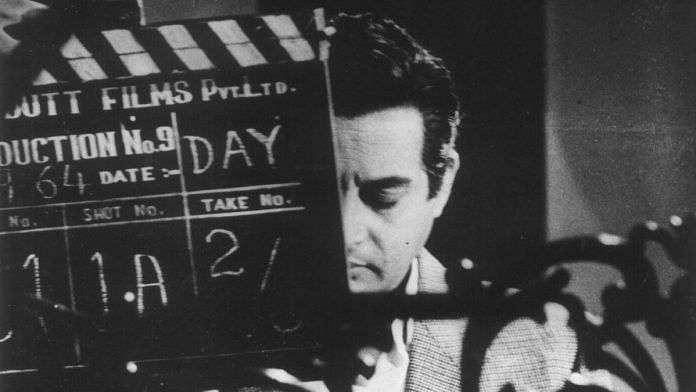The journey of the actor-filmmaker was full of challenges even as he made several classics, including Pyaasa and Kaagaz Ke Phool.
Actor, director and producer, Guru Dutt, the man behind classics like Pyaasa (1957) and Sahib Bibi Aur Ghulam (1960), was nothing short of a multi-faceted genius.
Born as Vasanth Kumar Shivashankar Padukone in Bangalore on 9 July, 1925, he was a victim of an accident early in his life, and got his his name changed to what he considered more ‘auspicious’.
In 2010, Dutt was included in CNN’s top 25 actors of all time, but the journey of the actor-filmmaker was full of challenges and ended with a tragic death on 10 October, 1964.
The making of a director, actor, producer
Dutt began working as a telephone operator in a factory in Calcutta (now Kolkata) while he was still in his late teens. But he soon left that job to join his parents in Bombay (now Mumbai). It was here that he honed his many raw talents. He did small parts in films like Chand (1944), and assisted on films like Lakhrani (1945). He even choreographed dance sequences in Hum Ek Hain (1946). He later started working at the premier production house, Prabhat Film Company.
Later, Dutt got an opportunity to work with two leading directors of the time — Amiya Chakravarty in Girls’ School and Gyan Mukherjee in Sangram.
It was around this time that rising actor Dev Anand started a production venture of his own called Navketan Films and offered Dutt the role of a director in the production house’s upcoming movies. As promised, Dutt went on to work with Navketan for his directorial debut called Baazi in 1951.
Also read: Comedy king Mehmood who earned more than the lead actors of his films
Not only did the movie catapult him as a shining new star, but was a personal landmark as well as Dutt met his future wife, singer Geeta Roy, the seductive voice behind Tadbeer Se Bigdi Hui Taqdeer. The two got married in 1953.
Baazi was followed by a producer-actor collaboration between Dutt and Anand in C.I.D (1956). In the meantime, Dutt continued wearing his directorial hat in successive movies like Jaal (1952) and Baaz (1953), the latter becoming his acting debut.
These movies led to the creation of ‘the Guru Dutt team’ — one of the finest filmmaking teams that continued to do great work even after his demise.
The team included writer Abrar Alvi, cinematographer V.K. Murthy and editor Y.G. Chawan. Of course, the legendary musicians behind classics in Dutt’s movies — O.P. Nayyar, S.D. Burman and Hemant Kumar, singers Geeta Roy and Muhammad Rafi and lyricists Sahir Ludianvi and Kaifi Azmi — were part of it too.
Actors Waheeda Rehman, Dev Anand, Johnny Walker and Rehman made for the illustrious cast in his movies.
Dutt and his team went on to deliver several successful movies — Aar Paar (1954), Mr. & Mrs. ’55 (1955), Sailaab (1956) and Pyaasa.
Time magazine later rated Pyaasa as one of the 100 best films of all time.
Dutt saw tremendous successes in his career, but also failures. The remarkable failure of his directorial Kaagaz Ke Phool (1957) at the box office despite starring Dutt and Waheeda Rehman served an important landmark in his personal and professional career.
His last film as an actor was Sanjh Aur Savera (1964) opposite Meena Kumari, directed by Hrishikesh Mukherjee.
Tragic personal life and death
Dutt and Geeta Roy were engaged for three years before they could gain the approval of their respective families for marriage. It was reportedly a strained marriage and the two separated eventually.
Author Nasreen Munni Kabir writes in her biography of Dutt, Guru Dutt: A Life in Cinema, that he had “an increasingly disillusioned and fractured state of mind”.
“Guru Dutt’s personal life was in turmoil, and he smoked and drank heavily,” wrote Kabir.
Also read: Remembering Yash Chopra, a filmmaker who was more than just the ‘King of Romance’
He died on 10 October, 1964, in his rented apartment on Peddar Road in Bombay. He is said to have been mixing alcohol and sleeping pills. His death may have been suicide, or just an inadvertent overdose. His son Arun believed it was the latter.
Dutt and his wife had three children — Tarun, Arun and Nina — who grew up in the homes of Dutt’s brother Atma Ram and Geeta Dutt’s brother Mukul Roy after their parents died while they were still very young.
Unfinished projects
Gouri, a film project launched in 1957 was to be the acting debut of his wife Geeta Dutt. But the film bit the dust after a few scenes were shot.
The two films that he left unfinished at the time of his sudden death were his own production, Baharen Phir Bhi Aayengi, and K. Asif’s Love and God, a take on the epic ‘Laila-Majnu’. Dharmendra later stepped in the role originally meant for Dutt.




His movies also had Mala Sinha. In fact she acted with him in outside banners as well.
The column feels incomplete without Chaudvin ka Chand. Guru Dutt singing to a sleeping Waheeda Reman, transcendent in her beauty, remains one of the most sensuous ever filmed.